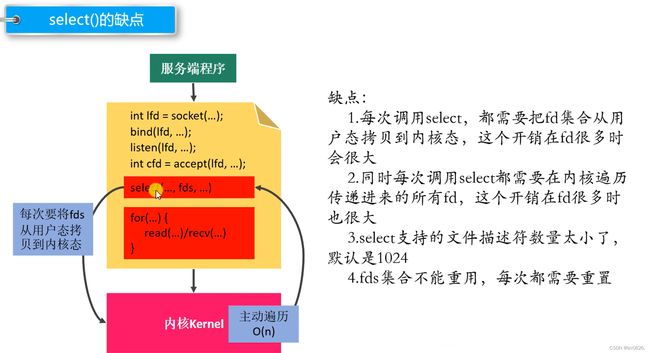第四章:Linux中I/O多路复用的poll技术--对select技术的改进
poll
poll技术是对select技术进行改进,所以select技术肯定具有缺点
select技术的缺点
当客户端多了的时候,也就是fd多了的时候,就会出现如下的一系列问题
其中的第四条就是不使用临时 tmp_set 的问题,read_set应该要继续检测的部分被置为0了,就因为这个时候没有数据进来,所以言下之意就是不能重用,每次都需要重置
poll()
使用时引头文件
#include 代码
代码的架构和前面的几乎没有区别,只有server.cpp进行了修改,这里只放出server.cpp
select技术的链接:
https://blog.csdn.net/m0_61588837/article/details/132411683?spm=1001.2014.3001.5501
// server.cpp
#include 代码分析
首先我们要理解结构体 pollfd 的含义
这是用来保存委托内核检测的文件描述符;委托内核检测的文件描述符的什么事件,比如读写,类似于select中的read_set;还有检测过后实际发生的事件,比如没有读,就修改,类似于select中的 tmp_set;的一个结构体
struct pollfd {
int fd; /* 委托内核检测的文件描述符 */
short events; /* 委托内核检测文件描述符的什么事件 */
short revents; /* 文件描述符实际发生的事件 */
};
值得注意的是这些事件的类型和存储方法,是short类型的,我们来看它可以描述哪些事件
其实他和文件属性stat变量里面st_mode(表示文件类型和权限)是一个道理,一个bit位表示一个权限,1表示有,0表示没有,因此添加权限应该用 按位或 | , 这里的事件也是一样的道理,我们一般判断读事件就POLLIN,写事件就POLLOUT
第三个参数就是经过检测之后的状态,可以用它来判断是否有检测到读;由于我们设置的event没有变化,所以相对于select()还是好了很多
其次,我们查看poll()接口的第一个参数是: struct pollfd *fds,需要一个结构体的数组传入进来,每一个元素就封装了一个文件描述符对应的信息,我们从0开始依次记录,如果该元素的fd为-1就表示没有使用,可以存放新的元素,注意这个下标,或者我们称他为索引,索引的值和文件描述符的值是不同的,为了提高效率我们这么设计,在代码中一定要注意,其他的逻辑没什么区别
还有一点,我们看如何判断最后的 revents 检测到读信息
还是前面的思想,每一位对应一个,读对应一位为1,其他为0;当然为什么不是直接相等呢?可能我们设置了其他性质也需要检测,内核处理后还是有了其他的性质为1,我们最好不要冒险,所以这里我们用 &
if (fds[i].revents & POLLIN == POLLIN)
//下面的操作


